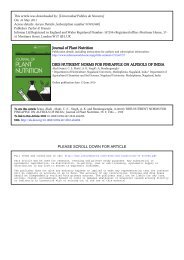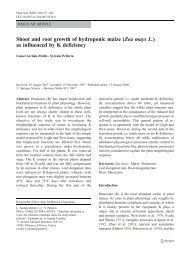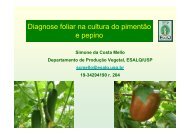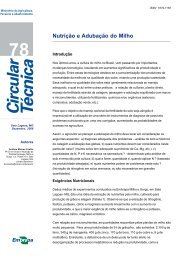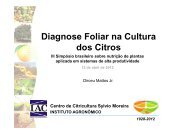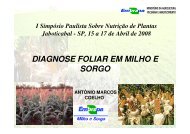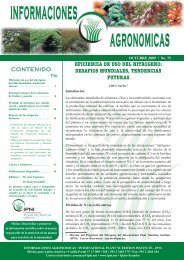Journal of Plant Nutrition - Nutricao de Plantas
Journal of Plant Nutrition - Nutricao de Plantas
Journal of Plant Nutrition - Nutricao de Plantas
You also want an ePaper? Increase the reach of your titles
YUMPU automatically turns print PDFs into web optimized ePapers that Google loves.
DRIS Norms for Aonla 553TABLE 4 Effect pH on Mineral composition and DRIS indices <strong>of</strong> leaf samples <strong>of</strong> aonla plants collectedfrom Central Indo-Gangetic plains <strong>of</strong> Uttar Pra<strong>de</strong>shLeaf compositionDRIS indicespHRequirement Yield kgRange N (%) P (%) K (%) Zn ppm N P K Zn or<strong>de</strong>r plant −17.5–8.0 1.77 0.085 0.623 52.21 −75 −12 −0.93 87 N>P>K>Zn 38.58.0–8.5 1.49 0.072 0.69 51.43 −224 −106 189 140 N>P>Zn>K 34.48.5–9.0 1.48 0.065 0.625 45.87 −1661 −2441 1969 2132 P>N> K>Zn 26.5>−9.0 1.45 0.048 0.703 42.98 −460 −7784 5766 2477 P>N>Zn>K 22.3Downloa<strong>de</strong>d By: [Universidad Publica <strong>de</strong> Navarra] At: 09:30 16 May 2011each nutrient was i<strong>de</strong>ntified, DRIS indices specified requirements or<strong>de</strong>rs asN>P>K>Zn in mostly all age groups <strong>of</strong> plants. Nitrogen was found the mostlimiting elements in all age group <strong>of</strong> plant (Table 3). In the soil pH range8.5–9 and >9, P was found to be the most limiting element (Table 4); whereasN was limited at soil pH < 8.5. In addition to the diagnosis <strong>of</strong> <strong>de</strong>ficient nutrientsin the old senile aonla orchards <strong>of</strong> Uttar Pra<strong>de</strong>sh, the DRIS techniquealso gave the or<strong>de</strong>r <strong>of</strong> necessity for nutrients; however it was difficult to <strong>de</strong>termineif a relative nutrient toxic or <strong>de</strong>ficient <strong>of</strong> greater concern. Whencompared age wise, a relative <strong>de</strong>ficiency for N, P, and K corresponding torelative sufficiency for Zn was <strong>de</strong>tected by the DRIS technique for the plantsabove the age group <strong>of</strong> 15 onwards. For the younger orchards (5 yrs old) arelative <strong>de</strong>ficiency <strong>of</strong> N, Zn, and K corresponding to the relative sufficiency<strong>of</strong> P was <strong>de</strong>tected. When the DRIS indices were compared on basis <strong>of</strong> soilpH, Zn and K was found to be relatively less than N and P in regards to theor<strong>de</strong>r <strong>of</strong> requirement.The DRIS approach can also be employed to compute <strong>de</strong>ficient, low,sufficient, high and toxic ranges for nutrients. Sufficiency ranges <strong>of</strong> nutrients<strong>de</strong>rived from a nutrient in<strong>de</strong>xing survey <strong>of</strong> aonla fruit trees are shown inTable 5. The leaf composition interpretations <strong>of</strong> <strong>de</strong>ficient, low, sufficient,high and toxic level <strong>of</strong> each nutrient are <strong>de</strong>fined (Bhargava, 2002) as follows:Deficient: This indicates that the effective supply <strong>of</strong> the nutrient is so low thatthere is a reduction in growth, yield, and quality. Clearly visible <strong>de</strong>ficiencysymptoms, if they appear, indicate an acute shortage and imbalances <strong>of</strong> thenutrient in the plant.TABLE 5 Nutrient status <strong>of</strong> aonla fruit trees orchards in orchards from Central Indo-Gangetic plains <strong>of</strong>Uttar Pra<strong>de</strong>sh (%)Elements Deficient Low Sufficient High ToxicN (%) 26 34 33 7 —P(%) 8 22 51 19 —K(%) 1 18 47 31 3Zn (ppm) 17 27 46 9 1



